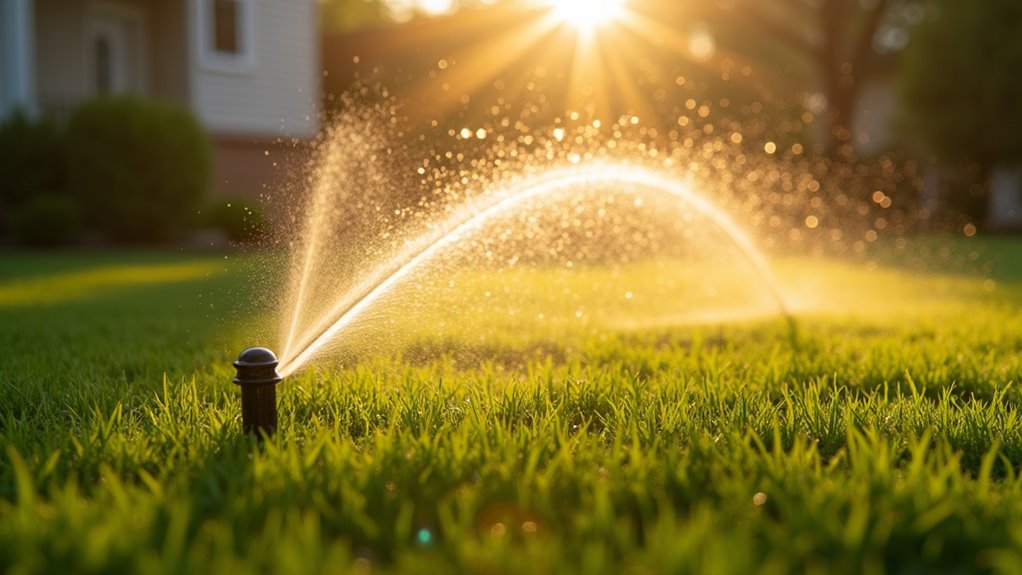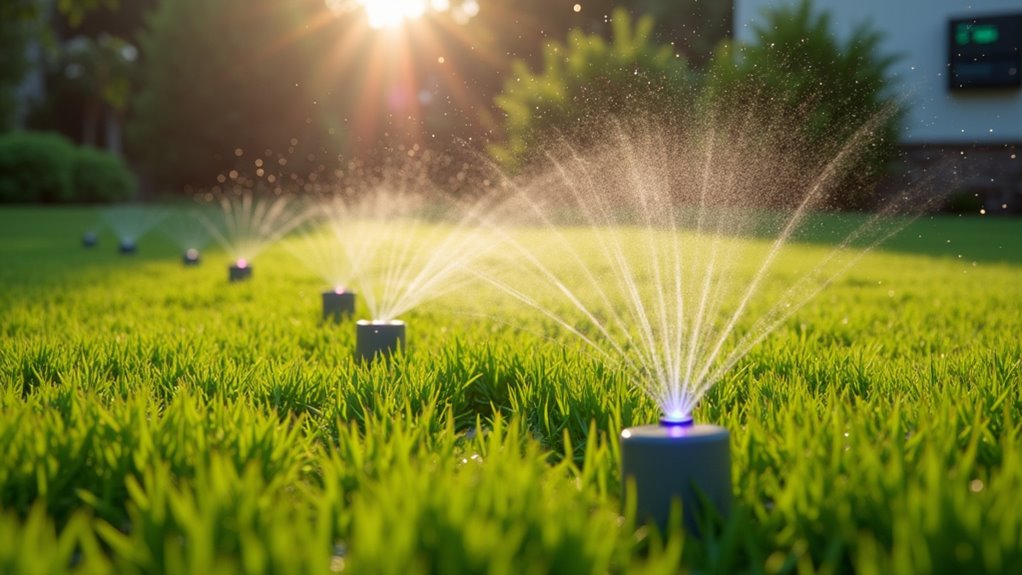Most lawn mowers use SAE 30, 10W-30, or 5W-30 oil, but it depends on your engine type. Four-stroke engines need standard engine oil in a separate reservoir, while two-stroke engines require oil mixed with fuel. Check your owner’s manual for the manufacturer’s specific recommendation based on your model and climate conditions. Using the wrong oil type or viscosity can lead to costly engine damage and reduced performance. The right choice protects your investment for seasons to come.
Understanding Lawn Mower Oil Basics
While many homeowners focus primarily on blade sharpness and fuel quality, understanding the proper oil for your lawn mower is equally critical to its performance and longevity. Your mower’s engine relies on oil for lubrication, cooling, and protection against wear.
Most lawn mowers use either conventional or synthetic 4-stroke engine oils, typically in SAE 30, 10W-30, or 5W-30 weights. These oil types offer different viscosity levels suitable for different operating temperatures and conditions. Check your owner’s manual for specific recommendations.
Adequate oil maintenance involves regular checks and changes every 25-50 operating hours or at least once per season. You’ll need to drain old oil completely before refilling to the appropriate level. Fresh oil guarantees maximum engine protection and prevents costly damage that can occur from running with degraded lubricant.
How to Identify Your Mower’s Engine Type
Before selecting the appropriate oil, you’ll need to determine whether you have a 2-stroke or 4-stroke engine in your lawn mower. Check your owner’s manual for definitive information on engine type and oil specifications for ideal engine compatibility.
Four-stroke engines have separate reservoirs for fuel and oil, with a distinct oil fill cap typically marked with an oil can symbol. Two-stroke engines mix fuel and oil together in the same tank, requiring no separate oil reservoir.
Look for model numbers on the engine casing, which often start with specific codes indicating engine type. Regular mower maintenance depends on correctly identifying your engine type. If you’ve lost your manual, search the manufacturer’s website using your model number to find specific oil requirements and maintenance guidelines.
The Difference Between 2-Cycle and 4-Cycle Mower Engines
Two-cycle and four-cycle engines differ fundamentally in their internal operation and lubrication requirements. In two-cycle engines, you’ll need to mix oil directly with the fuel at specific ratios (typically 40:1 or 50:1), as these engines lack a separate oil reservoir. Four-cycle engines, by contrast, maintain separate systems for fuel and oil, requiring you to add oil to a dedicated crankcase while keeping your gasoline unmixed.
Engine Design Differences
Understanding the fundamental differences between 2-cycle and 4-cycle engines is essential when selecting the proper oil for your lawn mower. The engine configuration impacts everything from maintenance needs to performance characteristics.
- Lubrication requirements differences – 2-cycle engines mix oil with fuel for lubrication, while 4-cycle engines keep oil and fuel separate with a dedicated crankcase
- Mower size considerations – 2-cycle engines are typically lighter and found on smaller equipment, while 4-cycle engines power larger, more powerful mowers
- Engine cooling methods – 2-cycle designs often use air cooling exclusively, whereas 4-cycle engines may utilize more sophisticated cooling systems to manage higher operating temperatures
You’ll find 2-cycle engines in handheld equipment where weight matters, while 4-cycle engines dominate walk-behind and riding mowers where greater power and durability are priorities.
Oil Mixing Requirements
Regarding lawn mower maintenance, proper oil mixing directly affects your engine’s performance and longevity. The key difference lies in engine design: 2-cycle engines require premixing oil with fuel, while 4-cycle engines keep these systems separate.
For 2-cycle mowers, you’ll need to mix oil and gasoline before fueling. Standard oil mixing ratios range from 40:1 to 50:1 (fuel to oil), but always check your owner’s manual for exact specifications. Incorrect ratios can cause smoking, poor performance, or engine damage.
Four-cycle engines simplify maintenance by using separate reservoirs. You’ll add straight gasoline to the fuel tank and oil to the crankcase. Never mix oil with fuel in these engines—doing so will foul spark plugs and potentially damage crucial components.
Decoding Oil Viscosity Ratings for Lawn Equipment
When shopping for lawn mower oil, you’ll encounter numbers like 10W-30 or SAE 30 that might seem confusing at initial glance. These viscosity ratings indicate how the oil flows at different temperatures, directly impacting your mower performance.
The viscosity rating system works like this:
- Single-grade oils (SAE 30) maintain one viscosity level and work best in consistent temperatures
- Multi-grade oils (10W-30) provide protection across temperature ranges—the “W” stands for winter
- The primary number indicates cold-temperature flow, while the second number represents hot-weather thickness
Always check your owner’s manual for the manufacturer’s recommended viscosity rating. Using the wrong oil viscosity can reduce engine protection, decrease fuel efficiency, and potentially shorten your mower’s lifespan.
Seasonal Oil Considerations for Optimal Performance
The changing seasons directly affect which oil will perform best in your lawn mower engine. In summer heat, use SAE 30 or 10W-30 oil to maintain proper viscosity and protection when temperatures exceed 80°F. As fall approaches, consider switching to SAE 5W-30 for better cold-weather starting performance.
Winter storage demands special attention to seasonal temperature effects. Before storing your mower, perform an oil change with fresh oil to prevent acidic buildup and engine corrosion during dormancy. Follow proper oil storage tips year-round: keep unused oil in sealed containers away from direct sunlight in a temperature-controlled environment. Never store oil outdoors where extreme temperature fluctuations can degrade its quality and protective properties. Label containers with purchase dates to track freshness.
Synthetic vs. Conventional Oil: Which Is Best for Your Mower?
Choosing between synthetic and conventional oil remains one of the most critical decisions you’ll make for your lawn mower’s longevity. Synthetic oils offer superior lubrication efficiency and temperature tolerance, extending engine longevity by reducing friction and wear in extreme conditions. While they cost more upfront, their performance comparison reveals they typically outlast conventional options by 2-3 times.
Consider these factors when deciding:
- Environmental impact – Synthetics produce fewer emissions and require less frequent changes, reducing waste
- Cost analysis – Higher initial price but longer change intervals offset conventional drawbacks
- Performance advantages – Synthetic benefits include better flow in cold temperatures, reduced sludge formation, and improved protection during hot summer operation
Your specific mower type, usage frequency, and climate conditions should primarily guide your selection.
Step-by-Step Oil Change Guide for Beginners
Changing your lawn mower’s oil requires gathering the right supplies initially, including new oil, a drain pan, and a wrench for the drain plug. You’ll need to run the engine briefly to warm the oil, then carefully drain the old oil into your collection container. After the oil has completely drained, replace the drain plug and refill the engine with fresh oil to the proper level indicated on the dipstick.
Gather Necessary Supplies
Before beginning your lawn mower oil change, gather these six essential supplies: fresh motor oil (matching your manufacturer’s specifications), a new oil filter (if applicable), an oil filter wrench, an oil drain pan, clean rags or shop towels, and disposable gloves.
Choose the right oil container types for your job—plastic quart bottles work well for small engines, while larger jugs may be more economical for multiple machines. Don’t forget proper oil measurement tools to guarantee accurate refills:
- Funnel with measurement markings to prevent spills
- Dipstick or sight glass for checking oil levels precisely
- Clear measuring cup for pre-measuring exact amounts
Having everything prepared before you start prevents mid-job interruptions and oil spills. Store your supplies in a dedicated box or on a workbench shelf for easy access during future maintenance sessions.
Drain and Replace
A proper oil change begins with preparation of your lawn mower on a flat, level surface. Start by running the engine for 5 minutes to warm the oil, making it easier to drain. Next, disconnect the spark plug, locate the drain plug, and position an approved container beneath it.
Remove the plug carefully and allow all oil to drain completely—proper oil disposal is critical for environmental protection. While draining, check your maintenance schedule to confirm you’re adhering to manufacturer recommendations. This simple routine dramatically improves engine longevity.
Once drained, replace the plug and add fresh oil through the fill port, monitoring the dipstick for proper levels. Consider upgrading your oil filtration system if you operate in dusty conditions. Wait five minutes before checking the final oil level to verify accuracy.
Signs Your Lawn Mower Needs an Oil Change
Just as your car requires regular oil changes, your lawn mower demands similar attention to maintain peak performance. Recognizing the warning signs early can prevent costly repairs and extend your mower’s lifespan.
Watch for these critical indicators:
- Visual cues – Oil discoloration (dark or milky appearance), visible debris in oil, or active oil leaks underneath the mower
- Operational issues – Unusual noises during operation, excessive smoke from the exhaust, or noticeable performance decline when cutting
- Engine problems – Engine overheating, difficulty starting, or strange smells (particularly burning odors)
Don’t ignore low oil levels during your routine checks. Maintaining proper lubrication prevents friction damage to internal components and guarantees your mower operates efficiently throughout the cutting season.
Common Oil Mistakes That Damage Mower Engines
Many homeowners mistakenly use automotive engine oil in their lawn mowers, which can cause accelerated wear on critical components due to improper detergent levels and additives. You’ll damage your mower’s engine by selecting the wrong viscosity oil, as small engines require specific weight ratings to maintain proper lubrication at operating temperatures. Choosing the manufacturer-recommended oil type and viscosity (typically SAE 30, 10W-30, or synthetic 5W-30) guarantees peak performance and extends your mower’s lifespan.
Using Automotive Engine Oil
Why do so many lawn mower owners reach for automotive oil when their equipment needs lubrication? The convenience of using what’s already in your garage often outweighs the concern for automotive oil compatibility. While some automotive oils can work in lawn mowers, you must understand the essential differences to prevent premature engine wear.
When considering automotive oil for your mower, remember these key points:
- Temperature ranges – Lawn mower engines operate at higher temperatures than cars, requiring oils formulated for this heat stress
- Additive packages – Automotive oils contain detergents and additives that may not suit small engines
- Viscosity requirements – Small engines typically need SAE 30 or 10W-30, not the heavier weights common in vehicles
Always check your owner’s manual before substituting automotive oil for manufacturer-recommended lubricants.
Incorrect Viscosity Selection
Selecting the wrong oil viscosity ranks among the most damaging mistakes lawn mower owners make when servicing their equipment. Using oil that’s too thick (high viscosity) forces your engine to work harder, increasing fuel consumption and reducing power output. Conversely, oil that’s too thin won’t provide adequate protection between moving parts, accelerating wear.
Always consult your owner’s manual for the manufacturer’s recommended viscosity grade. For most walk-behind mowers, SAE 30 works well in warmer temperatures, while SAE 5W-30 provides better protection during cold starts. Riding mowers often require SAE 10W-30 for their more complex engines. Keep in mind that seasonal changes affect ideal oil viscosity—what works in summer might not provide proper engine performance in spring or fall. Using the correct viscosity guarantees maximum protection and extends your mower’s operational lifespan.
Recommended Oil Brands and Products for Different Mower Types
While engine performance largely depends on using the correct oil type, choosing reputable brands specifically formulated for lawn mower applications can further extend your equipment’s lifespan. Oil brand comparisons reveal that manufacturers like Briggs & Stratton, Kawasaki, and Honda offer specialized formulations designed to withstand the high-temperature conditions common in small engines.
For ideal results across different mower types, consider these mower oil recommendations:
- Push mowers: Pennzoil Platinum 10W-30 or Valvoline 4-Stroke SAE 30 provide excellent protection for standard residential models
- Riding mowers: Castrol GTX 10W-40 or Mobil 1 Advanced Full Synthetic offer superior performance for larger engines
- Commercial mowers: Shell Rotella T6 Full Synthetic or Amsoil 10W-30 deliver improved protection for continuous heavy-duty operation





